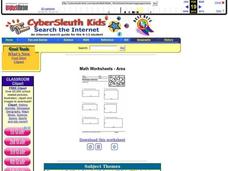GeoGebra
Pet Sitters Feasible Region
Find the best way to maximize the profit. Pupils graph four constraints of a pet-sitting company, using a revenue equation to find a maximum amount the sitters can earn. By using the equation, scholars determine the number of cats and...
Teacher Created Materials
A Volcano Awakes
Blow your pupils' minds with information about some of the world's most awesome natural occurrences: volcanos. Class members read a short article and respond to included questions. The focus of the resource is on understanding and...
National Wildlife Federation
Build a Bat House!
Bats usually get a bad rap. Scholars learn about the importance of bats and the threat their declining population has on the environment. They then build bat houses to attract and welcome bats into the area.
K12 Reader
The Bug on the Rug
Where did that bug go? Kids can find out where it is by reading this short poem that features -ug words and responding to the three included reading comprehension questions.
University of Kentucky
The Great Spider Debate
Poor, misunderstood spiders! They are feared, disrespected, and detested by many people, yet they do so many positive things. A great addition to any insect unit, learn about some of the more common spiders, while hopefully dispelling...
Scholastic
Study Jams! Number Lines
Step by step, two examples of creating number lines are explained through a series of animations. One is meant to watch at home, the second can be viewed in class, and there is a third tab with two sample problems to try. This skill,...
Florida Center for Reading Research
Vocabulary: Word Meaning, Word Clues
Young learners develop a deeper understanding of target vocabulary. In pairs, pupils independently complete a series of word clue cards, asking them to find information about key terms, including their definitions, synonyms, antonyms,...
Florida Center for Reading Research
Vocabulary: Word Meaning, Dictionary Digs
Young scholars dig through dictionaries to uncover the wealth of information they provide. Using the included graphic organizer, children learn about target words by finding their parts of speech, pronunciation, definition, synonyms, and...
Curated OER
Little House on the Prairie
Hop into a covered wagon and follow Laura Ingalls Wilder through the Midwest. A series of lessons based on Little House on the Prairie encourages young pioneers to see the world through Laura's eyes as they map her journey, discuss the...
Virginia Department of Education
Atomic Structure: Elements
It's all relevant, really. Individuals use the scientific method to learn more about elements, atoms, and their placement on the periodic table. They conduct experiments using materials common in nature to explore how elements affect our...
EduGAINs
Coureurs de Bois, First Nation Peoples, and the Fur Trade
The interactions between the Coureurs de bois (runners of the woods) and the First Nation Peoples as they engaged in the fur trade are the focus on this Canadian history exercise. Kids select learning centers based on their learning...
Polar Trec
What Can We Learn from Sediments?
Varve: a deposit of cyclical sediments that help scientists determine historical climates. Individuals analyze the topography of a region and then study varve datasets from the same area. Using this information, they determine the...
Intel
Help Wanted! Physicist
Groups discover physics as they take an assigned scenario, perform research about different aspects of the subject matter, and present their findings to the class. From the presentations, learners must develop and support a point of view...
National Center for Families Learning
The Summer Fun Summer Learning Dance Unit
Summer slide. Alas, not a term synonymous with a type of sliding board, summer slide refers to the fact that learning slips during summer break, especially in the areas of spelling and math facts. Enrich summer break with a...
California Department of Education
Where Am I Going?
How do I get where I'm going from here? The fifth of six college and career readiness lessons invites seventh graders to dig deep into the career of their choice. Once they complete their research, individuals relate their findings to...
New York City Department of Education
Isabella’s Garden
Create rows and rows of vegetables. Pupils use their knowledge of multiplication to find the number of vegetable shoots planted in a garden and ways to arrange the vegetables in the performance task. Teachers use the suggested unit...
Community Resources for Science
Food Webs/Clipfish
Human impact on habitats can be alarming. A hands-on activity has learners explore the impact of human interactions with different environments using a gamified approach. They simulate the impact of a species' abundance under different...
Radford University
Parallel Lines Cut by a Transversal
Use the parallel lines to find your way. After first reviewing geometric constructions and the relationships between angles formed by parallel lines and a transversal, young mathematicians write proofs for theorems relating to parallel...
Radford University
Escape from the Zombie Apocalypse - Exploring Quadrilaterals through Google Maps and Google Earth
Prepare for the zombie apocalypse ... by studying quadrilaterals? Given a map of an imaginary town, scholars identify quadrilaterals created by streets. They then use Google Earth and Google Maps to find parallelograms, rectangles,...
Chicago Botanic Garden
Meet the Naturalists
Studying plants is a full-time job—for some. After learning the ins and outs of phenology in the first three lessons in the unit, pupils explore the history of the science. The instructional activity highlights five historical...
EngageNY
The Binomial Theorem
Investigate patterns in the binomial theorem. Pupils begin by reviewing the coefficients from Pascal's triangle. They look at the individual terms, the sums of the coefficients on a row, and the alternating sum of each row. Individuals...
NASA
Packing for a L-o-o-o-ng Trip to Mars
Pack just enough to fit. Crews determine what personal items to take with them on a trip to Mars. Each team must decide what to take with them on a two-and-a-half year trip to Mars and whether their items will fit within the allotted...
Las Cumbres Observatory
Calculating the Age of Solar System Objects
The number of craters on the surface of solar system objects has a direct correlation to its age. Learners use the concept to determine the age of several objects in the solar system. Using satellite images, they count craters within a...
Curated OER
Perimeter and Area
In this math worksheet, students find the area of 6 rectangles. Although the title indicates otherwise, students are not asked to calculate perimeters. There is no instruction on the page.
Other popular searches
- Finding Area and Perimeter
- Finding Area in Square Units
- Finding Area of Triangles
- Finding Area of Shapes
- Finding Area of Rectangles
- Finding Area of a Triangle
- Finding Area Regular Polygon
- Finding Area of Polygons
- Finding Area of Circles
- Finding the Area of Rectangles
- Finding Area of Trapezoids
- Finding Surface Area Maps

























